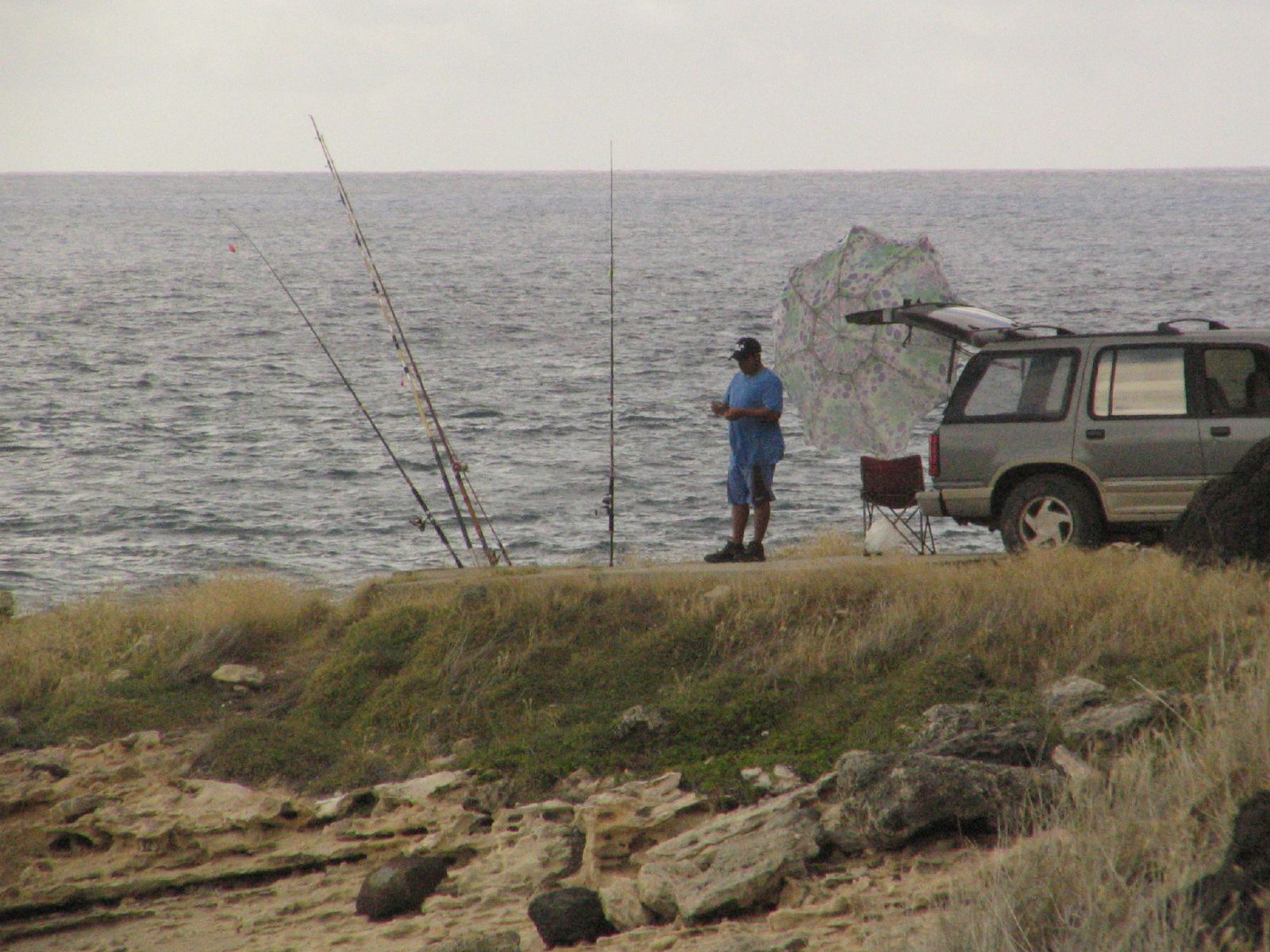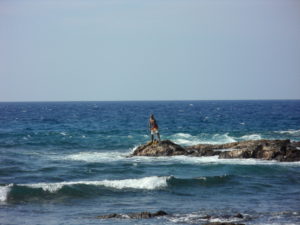There are so many physical activities you can do outdoors in Hawaii during a vacation, or as a permanent resident, but you might run out of things to do after a while if you’re adventurous. You shouldn’t be able to run out of things to do, there is just too much, but you might run out of the typical things you usually do.
Why not go fishing?
Hawaii is surrounded by the Pacific Ocean in an area of the world that still holds large numbers of many kinds of fish. One need only take a kayak out from the West side near Kaena Point and jump off with a spear in schools of mahi-mahi (Coryphaena hippurus) – one of Hawaii’s most delicious tasting fish. If you’ve never had a mahi sandwich – put it on your list of ‘must eat dishes’ in Hawaii. It is probably going to be one of your favorites like it is mine. They are excellent eating and just about every sit-down restaurant in on the islands offers mahi in a sandwich or presented in some other mouth-watering dish.
Another amazing fish is the Wahoo (Acanthocybium solandri). Hawaiians call it ono. It means best! They are my favorite fish to eat by far. Get one with a walnut sauce… oh wow. Swordfish is also great tasting fish barbecued with shrimp and… OK, look, I’m getting off-topic here with all this food talk. Let’s go fishing.
One of my favorite past-times is Hawaii shorefishing. I’ve spent many nights drinking with friends on the cliffs at Makapu’u and other places around the islands.
FISHING RULES AND REGULATIONS FOR HAWAII SHOREFISHING?
You’d probably be surprised at the few rules for shore fishing in the islands. There are some regulated fishing areas that you must know about before you grab your rods and tackle. Don’t just fish anywhere, take the time to research. It could save you a hefty fine. Click an island to see the list of areas: Oahu – Maui (includes Molokai, Lanai, Kahoolawe) – Kauai – Big Island.
Other than these special areas, you are OK to fish along the shores of Hawaii in the ocean. Do look for signs that mark the area off-limits for pole fishing from shore before you begin. Anyone can fish with a pole on the ocean shores of Hawaii without a salt-water fishing license. The regulations in place are more about spearfishing, freshwater fishing, and selling your catch. In short you can catch fish and release them all day, without fearing a couple hundred dollar fine like you’d get in Florida for some of the same relaxed type of fishing.
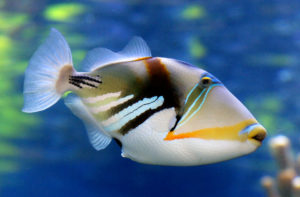
Reef trigger fish. by Bernard Spragg. NZ is licensed under CC0 1.0. Image may have been resized or cropped from original.
SPECIES OF COMMON NATIVE FISH YOU MAY CATCH IN HAWAII
- barracuda (kaku)
- bonefish (o’io)
- blue-striped snapper (ta’ape) yellow with 2 blue stripes down each side
- bluefin trevally (omilu)
- flagtail (aholehole)
- giant needlefish (aha)
- goatfish (moana)
- ladyfish (awa’awa)
- leatherback (lai)
- lizard fish (ulae)
- milkfish (awa)
- needlefish (i’i)
- Pacific threadfin (moi)
- peacock grouper – (roi) invasive species, full of ciguatera
- puffer (fugu)
- red-tailed snapper (to’au)
- rockmover wrasse (hinelea)
- rudderfish (nenuenue)
- soldierfish – squirrelfish (menpachi)
- snapper (wa’a nui)
- tableboss (a’awa)
- trevally (jacks) – when small under 15 lbs called papio, and when bigger called ulua
- triggerfish (hate)
- trumpetfish (nunu)
- unicorn fish (kala)
- sharks (mano) – I know, not a fish you may want to catch, but you’ll catch them.
The most exciting fish to catch, in my opinion, is the ulua, Caranx ignobilis. The big ones are around 180 pounds and they are great fighting fish, even the smallest ones are a blast to catch on light tackle. The big ulua are heavy and require a lot of strength and persistence to get them in to the shore. If you’re on the rocky cliffs while fishing, you’re going to need a gaff on a rope or be able to climb down to water level to hoist the fish out.
The little papio are also great fun to catch, a fifteen pound jack trevally is packed full of energy and will do amazing runs, smoking your reel and breaking your line if you’re not ready for it. Keep a loose drag for the runs! The big ulua are not great eating. Locals will eat them, but the biggest fish are the oldest fish and I’m too worried about high levels of mercury and other poisons in them to eat them. However, I really enjoy the smaller papio. Jacks have a strong taste that is not for everyone. Personally, I love the taste of the firm meat of the smaller jacks!
The best tasting fish in Hawaii are the ono, maona, snapper, grouper, and mahi-mahi. This is my opinion of course, but few would disagree these are all great eating fish!
A local guy, George ‘Keoki’ Stender, has a great site, “MarineLifePhotography.com” that lists many native Hawaii fish and other wildlife if you want to see some great photos.
SHOREFISHING TECHNIQUE
Fishing the ocean is much different than catching trout at your favorite lake or stream in the mainland. The fish are big, toothy, and have a lot of energy to make blazing fast runs. You’ll want to prepare accordingly.
If you’re standing on the beach and fishing you should probably have a seven to nine foot rod. The Ugly Sticks work well and are cheap enough. I’d go with 15 lb. test line. I prefer live and dead bait to lures, but many people throw lures successfully. I’d suggest hanging out in Hawaii fishing forums to listen in and get some help with what lures you might find useful. There are so many lures at the store, and you can bet the fish only hit 10% of them. Find out which plastic baits are best for Hawaii shorefishing before visiting the store or it will be a crap-shoot whether you land fish or not. Fishing is not half as much fun when the odds are not in your favor.
I typically just use live and cut bait, mostly white squid. I cut it into triangles of various sizes and whip that through the water a bit. See if anything comes out for lunch. You’ve got to really work an area to see if it holds fish. Try skimming the bait across the top of the water, fast. Try it slow, allowing it to sink a bit before you pull it again to the top on your retrieve. Try pulling it through the middle of the water fast. In particular, I’ve found small jacks like this presentation and will attack squid like this pretty often. You’ll also get the barracudas if they are about. They are very strong and no fun to land if you don’t have pliers to pull the hooks out. Barracuda are not good eating, they, and the reef fish have something called “ciguaterra” that can sicken you if you eat them. More on that below in “Cautions.”
WHEN TO FISH THE SHORES IN HAWAII?
If you can fish the first or last daylight – do that and ignore the tides. If you are fishing at other times, ideal fishing times will coordinate with strong incoming or outgoing tides, depending on the area you’re in. Fish the moving tides for best results, no matter where you are in the world, you can’t really go wrong with that advice.
CAUTIONS WHILE FISHING
If you’ve fished anywhere else in the world, you know that there are dangers to be aware of while fishing. In Hawaii there are a number of things to be aware of.
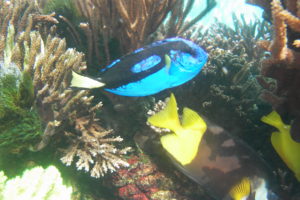
Hawaii 029 by 92329419@N00 is licensed under CC BY-SA 2.0. Image may have been resized or cropped from original.
1. Toothy Fishes. Some of the fish have monstrous teeth and you don’t want to get your hands near them. Barracuda and sharks come immediately to mind. But any fish, a parrot fish will snip your finger tip right off if given the chance. My dumb friend Wally, years ago when you could feed frozen peas to the fish in Hanauma Bay, held one pea out and a parrot fish bit his finger hard, taking a chunk of it with the pea. They have strong beaks and can crush coral. So, keep your hands and feet away from fish you land.
2. Surgeon Fish. These have scalpel like sharp projections near the tail that will rip open skin in a split second. Be very careful handling any fish, but definitely don’t touch one of these near the tail.
3. Rogue Waves. This is something that locals know all about, but still some people are killed on the cliffs while night fishing, or collecting opihi from the rocks. A rogue wave is one, or a series, that come as a set even during flat conditions. Once I was caught in a massive set on the North Shore while bodyboarding. Waves went from 10 feet Hawaiian scale to 15+ as soon as I paddled out, and I almost died – WITH a bodyboard to float me around. Rogue waves are nothing to mess with. Keep an eye toward the water at all times and stay substantially up and away from the water below while fishing from cliffs.
4. Criminals / Thieves. Personally I wouldn’t fish at night without at least two other guys with me. I wouldn’t fish alone. I wouldn’t fish with just me and my spouse or me and one male friend. I just wouldn’t feel safe enough. With three guys, I’d feel better. You should probably take the same precautions. Not that there are bands of people roaming around at night and terrorizing people fishing on the cliffs, but it happens. Your vehicle is especially vulnerable to a break-in while you fish in a remote spot. Better to have someone drop you off. Make sure you have batteries charged in your mobile phones.
5. Ciguatera Poisoning. Eating certain fish near the top of the food chain like snapper, amberjack, grouper, and ulua can kill you if you get this poisoning. One of the amazing side-effects / symptoms of poisoning by ciguatera is that you can feel very hot – when someone gives you cool ice or liquid in your mouth, and very cold when warm food or fluids are given. It reverses your sensations of hot and cold! Weird, right? What’s worse is that the symptoms – these and others like hallucinations – can last for months afterward. So, don’t eat barracuda or reef fish!
HOW TO AVOID CIGUATOXIN?
- Clean fish immediately after caught.
- Do not eat the head, guts, liver or roe (eggs) of any reef fish, especially big ulua, sharks and eels.
- Heat, drying, salting and freezing does not destroy ciguatoxin. It is impossible to tell by looking at a fish if it has it. Assume all fish mentioned above have ciguatoxin and avoid eating them.
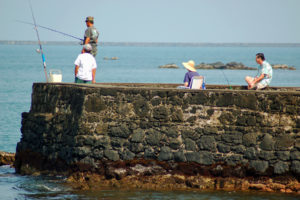
48 fishing for supper by leadfoot is licensed under CC BY 2.0. Image may have been resized or cropped from original.
WHERE TO FISH ON OAHU?
There’s a good reason there are hundreds of Oahu locals camped out over on the dirt road leading to Kaena Point. Big ulua is what most fishermen are looking for. They set up tents and camp there for days at a time, though the rules are still that they cannot do so. I don’t think anyone bothers them for a few days, maybe once a week. They move out then return and do it again. I think some people even live there long-term from what I can see by the extent of their interconnected tents and the glares I get as I bicycled by a couple of times. I felt like I was driving through their kitchen. The water is deep blue in this area, and goes down hundreds of feet at this spot. A host of deepwater fish are probably caught here regularly, not just ulua. Prime Hawaii shorefishing location!
WHERE TO FISH ON MAUI?
One fisherman mentions the mud-flat area past Ma’alaea Harbor on the way to Kihei. On the ocean side of Kealia Wetland and Wildlife Sanctuary. Wailea and Makena areas are also popular. Personally I’ve fished in Lahaina on the beach during the daylight and night hours and caught almost all triggerfish, parrotfish, and the occasional needlefish (i’i). I’ve also fished off some of the cliffs on the far west side out past Kahana and found that to be better (and much deeper).
WHERE TO BEGIN SHOREFISHING ON BIG ISLAND?
Just about anywhere on Big Island is good for fishing. There are so few people per square mile on the Island of Hawaii that you probably won’t have any problem finding a beach to fish at, or you could move to the rocks and fish from there. What I do when coming to a new island when I plan on doing some fishing from shore is I keep an eye out for where locals are already fishing. This, for a couple of reasons. Number one, they’ve already scouted around and if there’s a group of them, there’s a good reason for that! The second reason is that I want to talk to them and learn about what they catch in that spot, and other spots around the island. I have my favorite fish I like to catch – to eat usually – so I need essential information about where they can be found and what they’re striking.
WHERE TO BUY FISHING GEAR?
Walmart, Sports Authority, Target, and Long’s Drugs all have good supplies of the basics for fishing the shore – including some bait. You could rent fishing gear from various places, but probably better just to buy something cheap and strong at the store and leave it for the kids around your hotel or house when you’re done with it. Introduce a new generation to fishing!
WHERE TO FIND BAIT?
The stores mentioned above, as well as grocery stores for squid, shrimp, or other fish you want to try as bait on a hook.
Best of Luck! Aloha!

